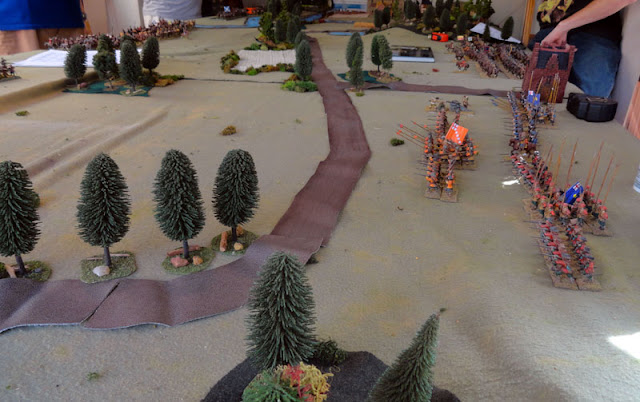I am lucky enough to game at a small but active club, which has members with a great diversity of interests, and between them a vast collection of wargaming resources.
For this test of the Pike and Shotte ruleset, two club members - Mike Schubert and Mike Karsten - contributed enough English Civil War figures from their collections for a game (on a table approximately 6ft x 18ft) with batallia-sized commands for 6 players. It was a fantastic introduction to an era and a conflict completely unfamiliar to me.
Over a swath of countryside, a Parliamentarian army (left of table in the first image below) of comprised of a foote battalia on each flank, and a central horse battalia supported by a small foote detachment, faced a Royalist attack. With a very similar deployment (horse battalia central, with a foote battalia on the far right, and a Scots Covenanter detachment on the right, supported by dragoons and light horse), the King's men planned their offensive.
 |
| Starting positions: Parliamentarian force at table left. |
 | ||||
| View from the opposite angle - left flank of Parliamentarian forces at right of pic. |
However, their confidence was met with an aggressive response from the Parlimantarian horse, who in the first few turns of the game routed the Royalist Horse, and punched a hole right through the centre of the Royalist line. Their right flank was now exposed to a threatening cavalry force. On the left, the Royalist Scots commanders struggled to maintain order within their units as they forded the river to the Abbey, resulting in their troops arriving piecemeal to engage an organised line of defenders.
 |
| Royalist Horse brimming with confidence. |
 |
| Charles Essex's regiment lead the line. |
 |
| Parliamentarian Horse counterattacks in the centre. |
 | |||
| A foote detachment advances to exploit the gains made by the Parliamentarian horse in centre field. |
The subsequent turns of the game saw the Royalist right forced into hedgehogs by the cavalry threat they faced, while suffering withering musket and ordnance fire - an unsustainable position. On the Royalist left, even a charge by a Highlander regiment did not buckle the defender's line. With that, the game was conceded.
Pike and Shotte feels to me (if I can be allowed to judge after just one game) to have benefitted from being the third in the Warlord rules series - it doesnt appear to have many of the "first edition" rough edges that are apparent in Black Powder, and the ruleset seems clearer and simpler than its older "cousins". I dont know enough about the era to judge how well Pike and Shotte represents the tactics and weaponry of the time, but the verdict from others around the table was positive.
You can find a project gallery of Mike Schubert's English Civil War army here.































